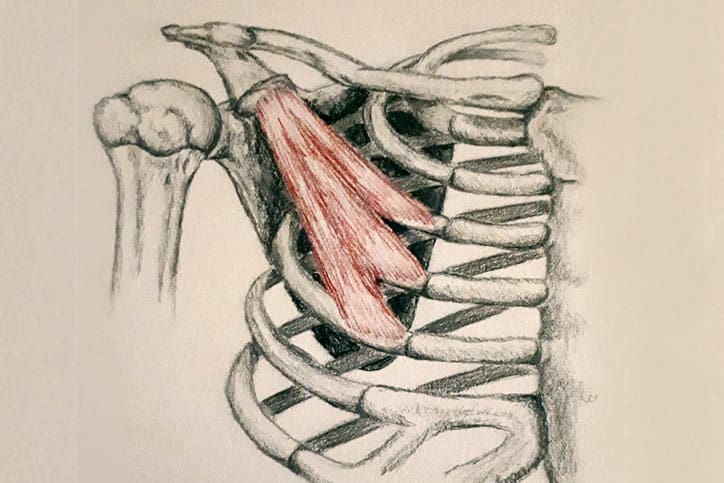Pec minor is one of the easier muscles to remember; however, it is encased within an impressive fascial layer called the clavipectoral fascia.
Pectoralis minor is triangular and found under pectoralis major, attaching from:
- The 3rd to 5th ribs close to the costal cartilage, variations are often found including an attachment to the 2nd rib.
- Going diagonally upward to the coracoid process of the scapula- The beak-like projection on the anterior portion of the scapula. Walk along your clavicle until you get to the acromioclavicular joint or basically until you hit your anterior deltoid, walk about 1 cm down. You should be able to palpate your coracoid process.
Palpate it – from the coracoid process drop inferior towards the ribs and bring your shoulder forward, you will feel pectoralis minor contract.

What does it do?
Whenever I am thinking of muscle action, I think what would happen if it pulls these two bony attachments closer together.
It will pull the scapula forwards and downwards closer to the upper ribs- protracts and depresses the scapula.
Its reverse mover action will pull the ribs up towards the coracoid process – Elevation of the ribcage – imagine you want to hold your breath for a long time, take a deep breath, feel what happens to the ribcage.
If the scapula is held close to the ribcage, it will restrict reaching up to get something from the top shelf of your cupboards or think about pegging your washing out.
The clavipectoral fascia:
It is deep to your pectoralis major and found between the clavicle and pectoralis minor. It splits to encase the pec minor, and it splits again to encase the subclavius muscle attaching to the clavicle. It helps permit glide of structures and protects the axillary vessels and nerve structures.
It creates a fascial envelope for your pectoralis minor/ subclavius and neurovascular structures. It is attaching medially to the fascia between the first two ribs and laterally attaching to the coracoid process.
We are never just working on one structure. We are always thinking of the muscle, fascial bag AND connections as well as the relevant nerves and vascular structures. For me, the thought of these muscles encased in this connecting fascial bag that extend to the axillary fascia and superiorly connecting into the deep cervical fascia (this cervical fascia is a whole new article) is very exciting. And helps you have a clearer intention with your manual technique or movement exercise.

